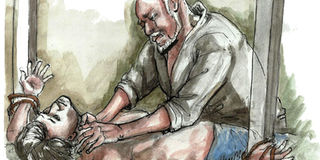Twist in case of the missing gay men

What you need to know:
- Part II. A vehicle one of the missing men was last seen getting into provided the police a break in the case, which has been described as the biggest forensic investigation in Toronto.
The criminal investigation into the disappearance of eight gay men, between 2010 and 2017 in Toronto, Ontario, Canada has been described as unprecedented and the biggest forensic investigation in the history of Toronto. It involved numerous scenes of crime, identification of skeletal remains and judicial authorisations for data hosted on foreign servers as the eight men used to date online.
Progress
The police created two task forces to investigate these cases and a breakthrough came when the disappearance of one of the men, Andrew Kinsman, on June 26, 2017, was reported within 72 hours. The police were able to track down the vehicle he was seen approaching the time he was last seen alive. Although the vehicle was sold a few months later, that is, in September that year, the police recovered it intact in October from the buyer.
Traces of blood were found in the vehicle and the blood was identified as that of Kinsman. Another DNA match was also found in the van for Selim Esen aged 44 years, who had also disappeared, two months earlier than Kinsman.
The previous owner of the van was Thomas Donald Bruce McArthur, a Canadian landscaper, born on October 8, 1951. The DNA evidence obtained in the van allowed investigators to obtain a general warrant to search McArthur’s apartment. The police then covertly entered McArthur’s residence and cloned his computer’s hard drive.
Connection is made
On January 17, 2018, police obtained evidence directly connecting McArthur to the disappearances of Esen and Kinsman. A partial download from McArthur’s computer, which was going through forensic analysis of deleted files, yielded postmortem photos of the victims. Round-the-clock surveillance was then put on McArthur, with instructions that he should immediately be arrested if observed “alone with anyone”.
The bust
On January 18, 2018, in mid-morning, McArthur entered his apartment building accompanied by a young man. Shortly afterwards, police officers ascended to McArthur’s 19th floor apartment and broke down the door. Inside, they found his companion already tied to the bed. The man was shaken but not injured.
The man who had arrived in Canada from the Middle East five years earlier, was married and had not told his family that he was gay. He had met McArthur through a dating app and they had met several times before. He had agreed to keep his relationship with McArthur secret, and had let himself be handcuffed to McArthur’s steel bed frame. McArthur put a black bag over his head and tried to tape his mouth shut before the police officers interrupted him.
Evidence gathered
The police seized electronic devices from the apartment as they already had a search warrant for the apartment, obtained after gaining blood evidence from McArthur’s van. The electronic devices seized included cell-phones, computers, digital cameras and flash drives. The computers had grisly photos of the victims which McArthur kept as trophies.
The evidence found in McArthur’s apartment shortly after the arrest prompted investigators to charge McArthur with two counts of first degree murder in the presumed deaths of Andrew Kinsman and Selim Esen. Their bodies had not been found but the police said they had a pretty good idea how they had died. The police were satisfied that there was enough evidence for murder convictions even without the bodies
Narrow escape
Sean Cribbin, a 50-year-old lived to tell his story. In 2016, he accepted an online invitation to meet McArthur early one afternoon. During their encounter, Cribbin stated in an interview that he felt comfortable submitting to McArthur’s wishes because he looked so unthreatening. Cribbrin narrated that he accepted a cocktail prepared by McArthur to put him at ease, cause euphoria and heighten the sexual encounter.
After he accepted the restrains that McArthur suggested, McArthur then tightened his hands around his victim’s neck, causing him to begin sweating profusely. Just then McArthur’s roommate entered the apartment and this provided them with an excuse to end the date.
Unknown to Cribbin, McArthur had photographed the encounter. Police later approached Cribbin with a photograph of him taken from McArthur’s home, showing him restrained in what the investigators called “the kill position”, moments away from certain death.
TO BE CONTINUED




